Rhipsalis Varieties: Identification and Care Tips
Get ready to discover the captivating world of Rhipsalis cacti! These unconventional plants, with their hanging, thornless branches, are like the rebels of the cactus family. But there’s more to them than meets the eye. In this blog, we’ll explore the various types of Rhipsalis, from the Mistletoe cactus with its thread-like stems to the Jungle Cactus with its short, yet beautifully branched shoots.
But it doesn’t stop there – we’ll also delve into the secrets of caring for these delightful cacti. From finding the perfect location and soil to watering just right, we’ll uncover the tips and tricks for keeping your Rhipsalis happy and thriving. So join us on this journey and get ready to bring some hanging beauty into your life with Rhipsalis cacti!
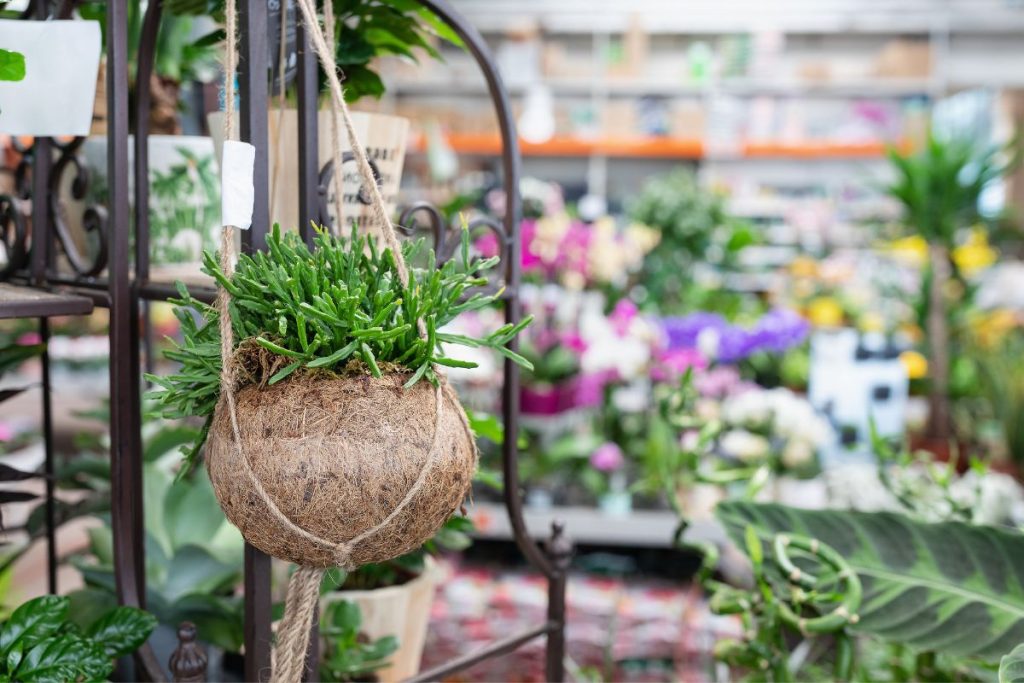
Contents
Characteristics of Rhipsalis
Rhipsalis is a plant genus from the cactus family known for its unique characteristics. These plants have thin, interwoven branches that hang down, giving them a distinct appearance. Sometimes referred to as the chain cactus or mistletoe cactus, many species of Rhipsalis originate from the rainforests of South America. It is the largest genus of epiphytic cacti, with about 35 distinct species.
Rhipsalis typically grows shrubby and has hanging shoots without thorns, but they may have woolly or bristly stems. During early spring, they produce small, berry-like fruits. The branches can reach around 31 inches long, and young shoots initially grow upright before developing overhanging, golden-yellow bell-shaped flowers.
Rhipsalis Types
Let’s explore some Rhipsalis varieties with pictures for identification:
Rhipsalis baccifera (Mistletoe cactus)
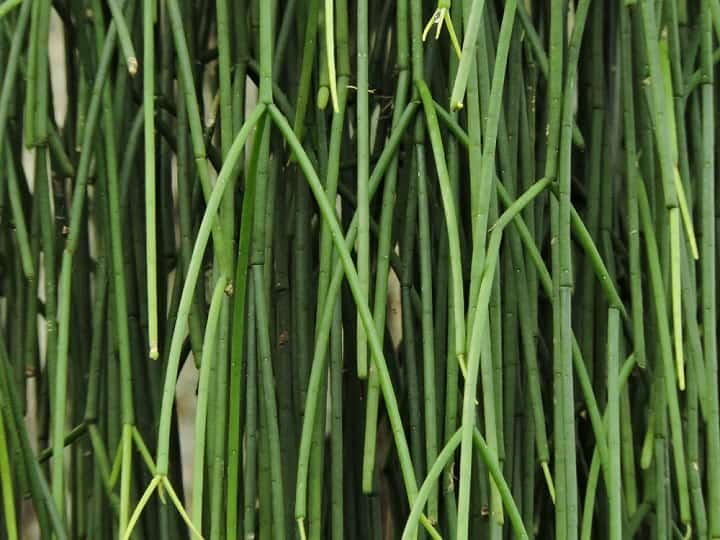
Rhipsalis baccifera, also known as Mistletoe cactus or Spaghetti cactus, is a graceful succulent that will add charm to any space. Its long, thread-like stems give it a unique appearance, and it produces numerous creamy-white flowers followed by mistletoe-like fruits. These plants can form large hanging clusters that can range from 3 to 13 feet long, occasionally reaching up to 30 feet.
Like most cacti, Rhipsalis baccifera has succulent stems. However, in this particular species, the stems are weak, slender, and narrow, giving it a delicate and elegant appearance. Rhipsalis baccifera is the most frequently grown species among the Rhipsalis genus. The existence of various geographically isolated populations has led to considerable polymorphism and the division of this species into numerous subspecies.
Rhipsalis burchellii
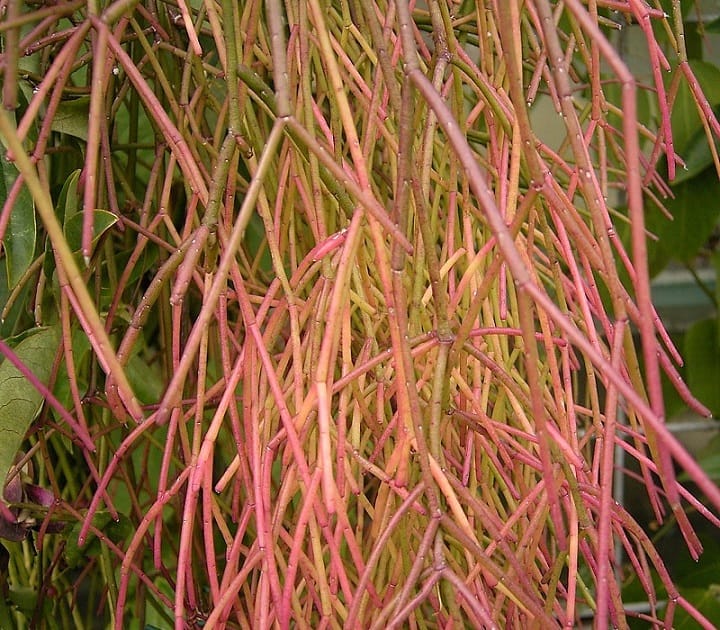
With its vibrant, purple-colored shoots, Rhipsalis burchellii is an intriguing species that will capture your attention. The shoots of this plant can grow up to 24 inches long, creating a visually striking display. Its growth habit is widely branched, and when in bloom, it produces many white, bell-shaped flowers that add a touch of elegance to its already captivating appearance.
Rhipsalis campos-portoana (Jungle Cactus)
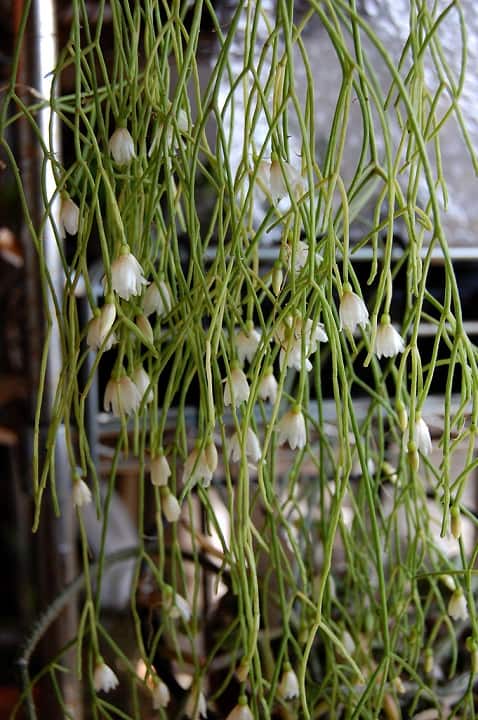
If you’re looking for a unique plant to add to your collection, Rhipsalis campos-portoana, also known as the Jungle Cactus, is worth considering. Despite having relatively short shoots, it compensates with rich branching, creating a lush appearance. At the tip of these branches, you’ll find quite large, white flowers that bring a touch of beauty to this remarkable plant.
Rhipsalis cereoides
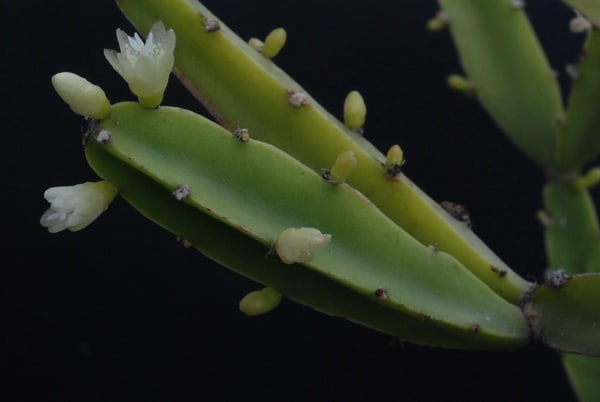
Rhipsalis cereoides is a fascinating species that showcases its uniqueness through its short shoots. These shoots typically measure only about 4 inches long, setting it apart from its longer-stemmed counterparts. What it lacks in size, it makes up for in its upright growth habit and striking triangular or square shape. During the blooming season, Rhipsalis cereoides produces white flowers, enhancing its charm and making it stand out among other cacti.
Rhipsalis crispata
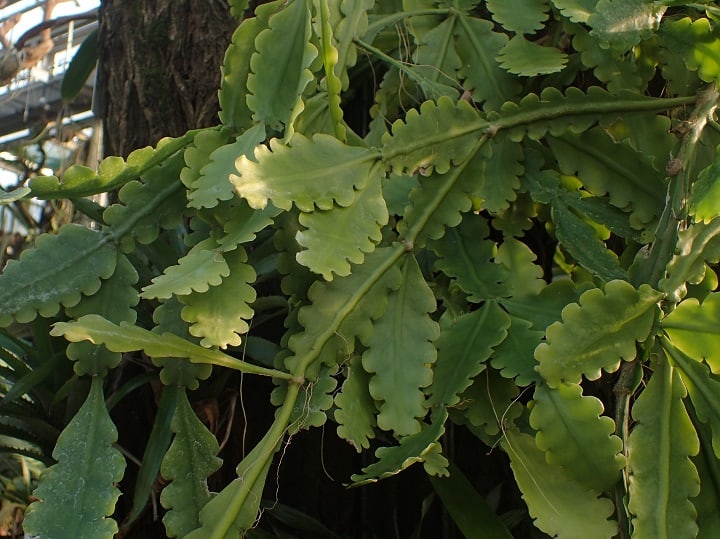
With its pale green shoots, Rhipsalis crispata is an attractive species that will bring a fresh and vibrant touch to any space. These shoots can grow up to 24 inches long and have leaf-like widespread limbs with notched leaf margins, giving them a distinct appearance. While the shoots of Rhipsalis crispata are not as hanging as other species, they produce small white flowers, adding delicate beauty to this eye-catching plant.
Rhipsalis cereuscula
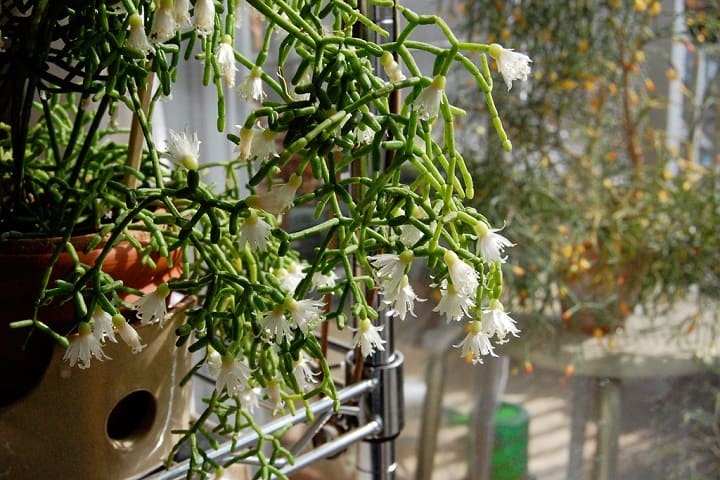
Rhipsalis cereuscula, also known as ‘rice cactus’ or ‘coral cactus,’ is a shrubby to bushy succulent epiphyte that offers a unique visual spectacle. Its stems can reach up to 24 inches long and are adorned with a multitude of tiny cylindrical stems at the ends of long, slender branches. This distinctive characteristic sets it apart from other Rhipsalis species. Rhipsalis cereuscula typically branches profusely, creating a pendent growth habit. To add to its allure, this species bears tiny creamy white blooms that bring an elegant touch to its overall appearance.
Rhipsalis clavata
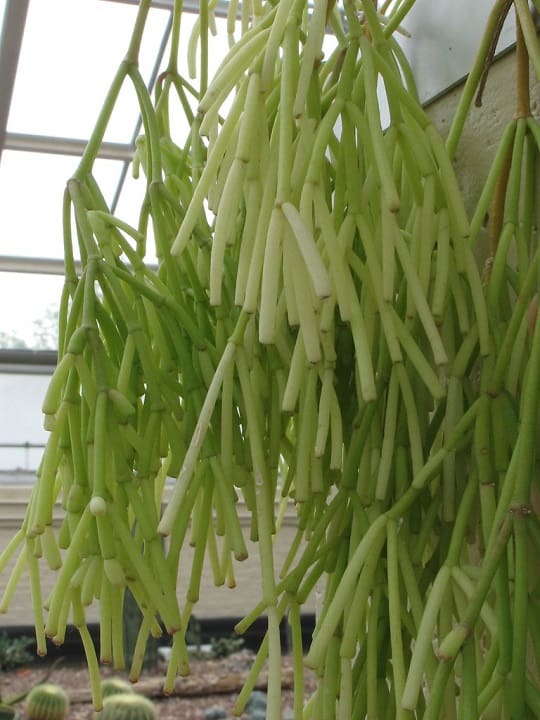
Are you searching for a plant that is perfect for hanging? Look no further than Rhipsalis clavata. With its pendulous growth habit, well-branched structure, and white bell-shaped flowers, it is an excellent choice for adding a touch of botanical beauty to your hanging displays. The cascading branches of Rhipsalis clavata, adorned with its stunning blooms, will create a striking focal point in your indoor or outdoor spaces.
Rhipsalis elliptica
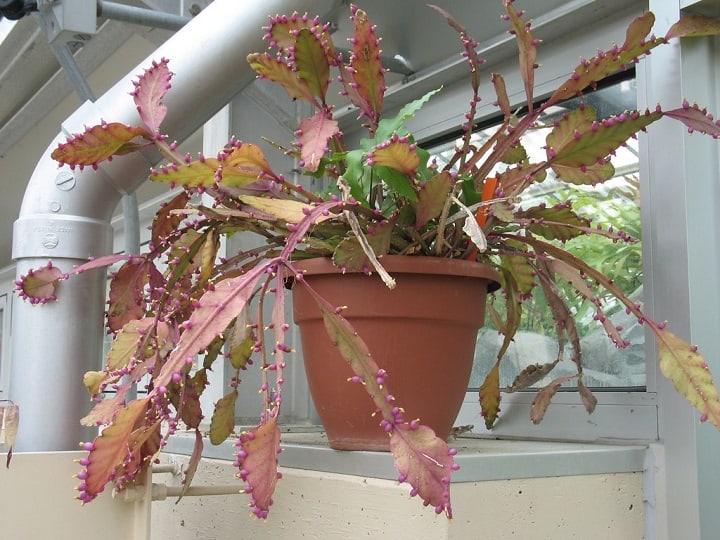
Rhipsalis elliptica is a species that boasts shrubby hanging shoots. These shoots are distinguishable by their dark green, shiny, and rather flat appearance, which exhibits characteristic separations along their length. The constrictions add a touch of unique allure to this beautiful species. When in bloom, Rhipsalis elliptica produces show-stopping white flowers. Overall, Rhipsalis elliptica is a captivating plant that brings both visual appeal and a sense of natural beauty to any environment.
Rhipsalis floccosa ssp. tucumanensis
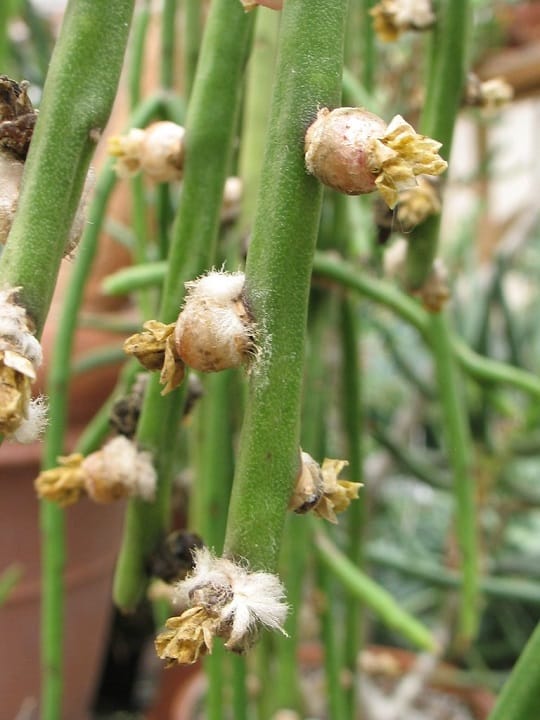
For a truly striking addition to your collection, consider Rhipsalis floccosa ssp. tucumanensis. This species, typically found hanging from the branches of large trees in the jungle canopy, showcases many slender segmented branches measuring 0.2 to 0.4 inches in diameter, often forming whorls.
While similar to subspecies pulvinigera, Rhipsalis floccosa features green stems without red coloring. It also produces larger fruits, measuring about 0.4 inches in diameter, which can be red or white. The stems of Rhipsalis floccosa are initially covered in woolly areoles when young, but they eventually become naked.
Rhipsalis grandiflora
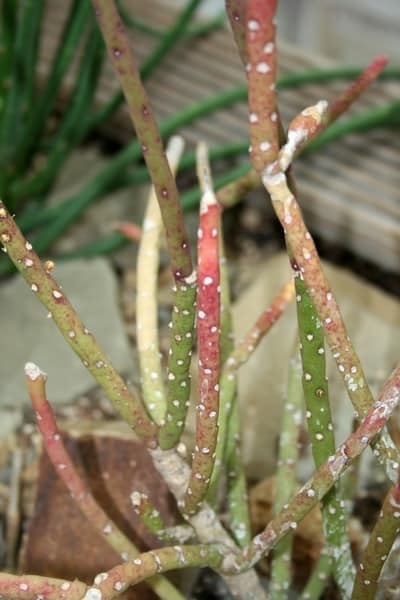
If you’re looking for a showstopper, Rhipsalis grandiflora is the perfect choice. This species boasts graceful, long shoots with slightly red-colored tips that add a touch of vibrancy. When in bloom, it produces large cream-colored flowers that stand out against the lush foliage of the plant. Rhipsalis grandiflora is an ideal candidate for container gardening, bringing elegance and beauty to any space it graces.
Rhipsalis houlletiana
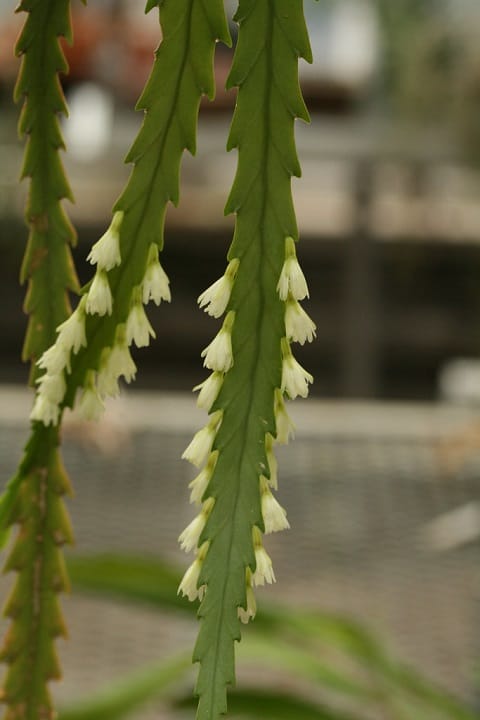
Rhipsalis houlletiana is a visually intriguing species that features stem-like, light green shoots. Each shoot has the ability to form two distinct types of branches: one that is very slender and cylindrical, and another that is leaf-like and widespread. This fascinating characteristic adds a dynamic dimension to the plant’s appearance. Rhipsalis houlletiana also produces many yellowish-white flowers, further embellishing its unique charm.
Rhipsalis mesembryanthemoides
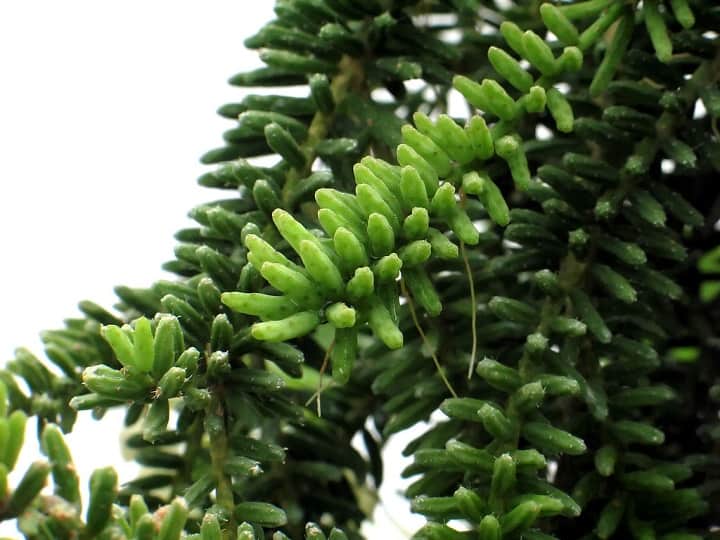
Rhipsalis mesembryanthemoides is an epiphytic plant characterized by its strong stems, which are covered in tiny branchlets. Initially, this plant grows erect, but as it matures, it becomes pendent and branches freely, creating a cascading effect. The elongated, cylindrical, and woody main branches can reach up to 7.9 inches in length and are about 0.04 to 0.08 inches in diameter. The exquisite white flowers emerge at the branchlets’ areoles, adding a touch of delicate beauty. Additionally, the berries that adorn the leafy segmented stems are white and almost transparent, enhancing the overall appeal of Rhipsalis mesembryanthemoides.
Rhipsalis oblonga
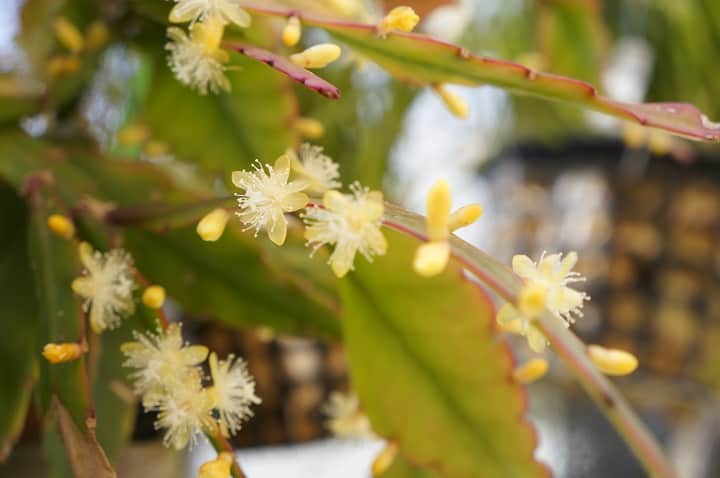
With its substantial size and striking appearance, Rhipsalis oblonga is a standout species that deserves attention. These semierect to pendent shrubs can reach up to 8.2 feet long. The main stems begin as terete at the base, gradually flattening above, and produce apical or lateral branches. Rhipsalis oblonga is a very free-flowering species, featuring pinkish-white fruits that add an extra allure to its overall charm.
Rhipsalis pachyptera
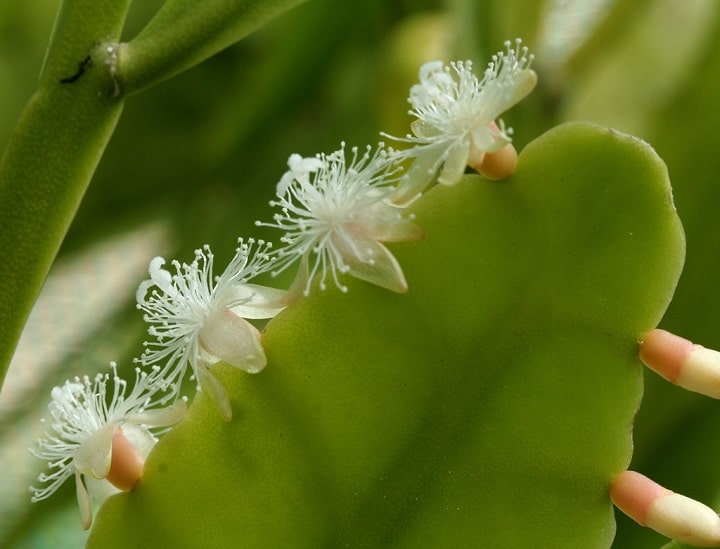
Rhipsalis pachyptera is an impressive epiphytic or lithophytic succulent plant that is sure to make a statement in any display. With a semierect to somewhat pendent growth habit, these plants can reach a length of 2.5 to 5 feet. The stems are robust and spineless, boasting many large, wide leaf-like joints that are frequently referred to as leaves. The flattened stems are broadly elliptic, and their color can vary from pale fresh green to deep green, sometimes with reddish tinges. Rhipsalis pachyptera often develops many buds at one areole and produces creamy-yellow or whitish flowers, which are followed by an abundance of white fruits, making it a standout addition to your plant collection.
Rhipsalis pilocarpa
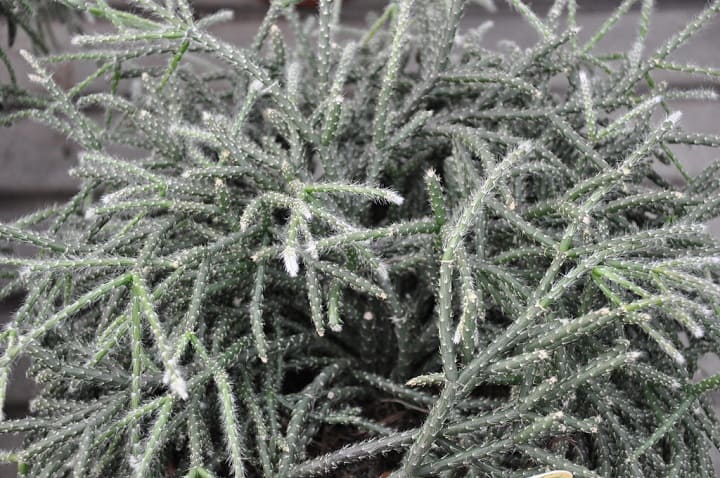
For a particularly captivating tropical addition, look no further than Rhipsalis pilocarpa. Hailing from Brazil, this attractive plant features long, hairy, cylindrical stems that add a unique textural element. It produces white, very fragrant flowers measuring about 0.8 inches in diameter, providing a stunning visual and aromatic experience. Rhipsalis pilocarpa forms pendent bushes and exhibits considerable variability, with reddish to purple-colored edges and creamy white flowers enhancing its decorative appeal.
Rhipsalis platycarpa
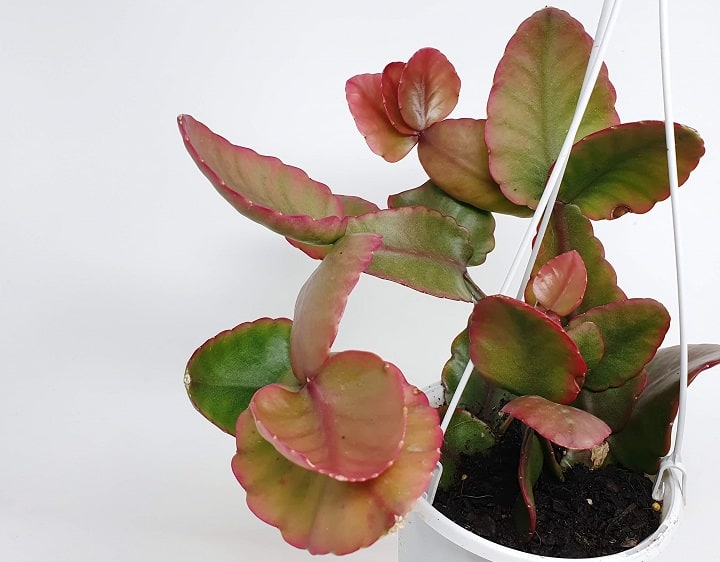
Rhipsalis platycarpa is an epiphytic species that brings a touch of elegance to any arrangement. These plants produce semi-trailing arching stems adorned with flattened leaf-like joints, reminiscent of Schlumbergera species. With stems that can reach up to 31 inches long, Rhipsalis platycarpa creates a visually stunning display, adding a sense of structure and beauty to your plant collection.
How To Care For Rhipsalis
Taking care of Rhipsalis cacti is super easy and doesn’t require any magic tricks. The key is to find the right balance when it comes to watering. These cacti don’t want to be too wet or too dry. Along with watering, the plant substrate and the right location are important factors to consider. Rhipsalis plants are like rainforest dwellers—they prefer bright but indirect sunlight, seeking shade under large trees. It’s important to note that they don’t like direct, bright sun. Also, avoid fertilizing them in winter; wait until the flowers bloom. And the best part is, you don’t have to worry much about trimming these cacti unless there are damaged or excessively long parts that need removal.
Rhipsalis doesn’t hibernate and can tolerate warm and bright conditions while needing only a little watering. If you want to expand your Rhipsalis family, you can propagate them through cuttings. Simply select healthy shoots, let the cuts dry for a few days, and then plant them in a suitable container. Disease occurrence is rare if you care for them properly. However, pests like mealybugs can be a nuisance, especially during winter. Keep an eye out for these fluffy white pests and take action as soon as you spot them.
Location
Finding the right spot for your Rhipsalis is essential. They enjoy a bright location, but be careful not to expose them to direct sunlight. While they can handle morning and evening sun, direct afternoon sun can be a bit too harsh for their delicate nature. So, a partially shaded location is perfect, allowing them to thrive without getting sunburned.
Rhipsalis loves the indoors and can stay in a normal living room all year round. However, during the summer, they can be safely placed outdoors, as long as they are protected from intense sunlight, wind, and rain. These plants appreciate slightly higher humidity, so if you can provide that, they’ll be even happier.
Soil and Planting
When it comes to the soil, Rhipsalis has its preferences. Normal potting soil doesn’t suit them well. You can use commercially available cactus soil, but it’s more economical and better to mix it yourself. Don’t worry; it’s not complicated. You can follow a simple recipe to make the perfect soil mix for your Rhipsalis.
When planting or repotting your Rhipsalis, handle the delicate roots with care. It’s best to do this in spring, although it’s possible to plant or repot before autumn too. After removing the cacti from their substrate, clean the vessel, fill it with fresh soil, and place the cactus back in. Remember that Rhipsalis roots are usually small, so larger vessels are rarely necessary.
To encourage overhanging growth and even development, make sure the plant has space on all sides. You can rotate the vessel regularly, whether it’s a hanging basket or a regular pot. This way, all sides receive enough light for continuous growth and uniform appearance.
Watering
Watering Rhipsalis requires a gentle touch, considering the season and the cactus’s needs. It’s crucial to avoid letting them completely dry out, but at the same time, excessive watering should also be avoided. Always allow the surface to dry thoroughly before watering, especially during the main growing season in spring and summer. In autumn, reduce the amount of water significantly. In winter, water very moderately. Rhipsalis cacti are sensitive to lime, so it’s recommended to use very soft water, preferably rainwater. Don’t forget to ensure sufficient humidity, especially by using an evaporation container nearby.
Fertilizing
To encourage buds to form, fertilize your Rhipsalis every 14 days until some of the buds have opened. Fertilizing during the blooming season can provide extra nourishment to promote healthy growth and beautiful flowers.
Pruning
Usually, Rhipsalis doesn’t require much pruning. However, if your plant becomes too big or you notice damaged or excessively long parts, you can trim them without any problems. These cut-off shoots can even be used for propagation. When trimming, choose the cuts strategically to ensure aesthetics, making them less visible or ending them where a joint naturally occurs. Even shoots with spots or damage can easily be trimmed using clean and preferably disinfected cutting tools to prevent the introduction of pathogens.
Overwintering
Unlike many other cacti, Rhipsalis doesn’t hibernate. However, it’s important to note that they are not hardy and cannot survive in outdoor conditions. During winter, you can place water-filled bowls near radiators to maintain sufficient humidity. Regularly check for pests, especially when humidity levels are low. It’s best to water your Rhipsalis a little, ensuring it doesn’t dry out completely. Avoid fertilizing or repotting during this period, allowing the plant to rest and conserve energy for the upcoming growing season.
Diseases and Pests
When you provide proper care conditions, Rhipsalis rarely experiences diseases. However, overwatering can cause root rot. On the other hand, pests can be a nuisance, particularly during winter. Mealybugs are the main culprits that bother Rhipsalis. These pests can be identified by fine, white webs and small, cotton-like structures on the plant. They suck out the sap and can cause significant damage.
If you spot mealybugs, it’s important to isolate the infected plant to prevent them from spreading. Systemic agents that are absorbed by the plants work best for controlling mealybugs. However, keep in mind that Rhipsalis may not tolerate these treatments well, so use them with caution.
How to Propagate Rhipsalis Cacti
Rhipsalis can be propagated through cuttings and seeds. Here are the steps for each method:
Propagation by Cuttings
- Select healthy shoots that are around 3 to 6 inches long.
- Allow the cuts to dry for a few days.
- Plant the cuttings in a suitable medium, about 1.5 inches deep.
- Place them in a bright location, but avoid direct sunlight.
- Maintain temperatures between 68 and 77 degrees Fahrenheit.
- Keep the medium slightly damp, and cover the container with a transparent plastic bag to maintain high humidity.
- Ventilate the container daily to prevent mold growth.
- After 3 to 4 weeks, roots should have formed, and the young plants can be treated as usual.
Propagation by Seeds
- Extract the seeds from ripe and soft fruits by mashing and separating them from the pulp.
- Alternatively, open the fruit and let it dry in sand. Roughly free the seeds from the pulp before rubbing the sand to separate them.
- The best time for seed propagation is from June to mid-August.
- Use a mixture of herb soil and fine pumice gravel as a medium.
- Place the seeds on the surface and lightly press them without covering with soil.
- Keep them in a partially shaded area.
- Maintain temperatures between 68 and 82 degrees Fahrenheit.
- Keep the medium evenly moist.
- Germination can occur throughout the year in a well-lit and heated greenhouse.
Remember to be patient as seed propagation can be more challenging than using cuttings.
Frequently Asked Questions
Are Rhipsalis toxic to cats and dogs?
When it comes to Rhipsalis cacti, their toxicity to cats and dogs is still uncertain. It’s best to err on the side of caution if you’re unsure about their effects on your furry friends.
The tricky part is that Rhipsalis cacti are often mistaken for Euphorbia, which is also known as the spurge. Some types of Rhipsalis closely resemble these plants. However, the key difference is that Rhipsalis cacti don’t release the white sap that’s characteristic of spurge plants when they’re cut. This makes them less likely to cause skin irritation.
While not all spurge plants are toxic, their sap can irritate the skin of many people and may cause discomfort, stomach cramps, and vomiting if ingested.
